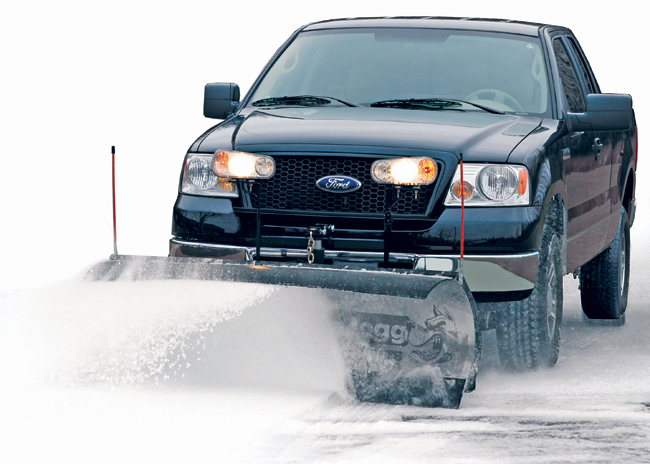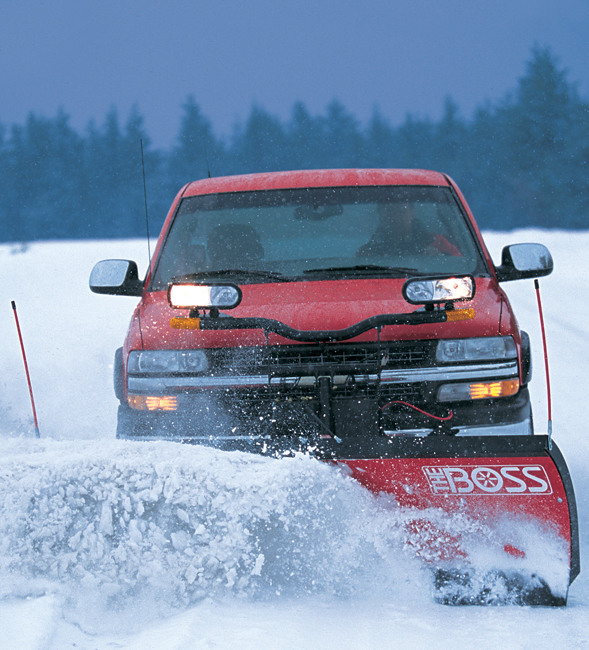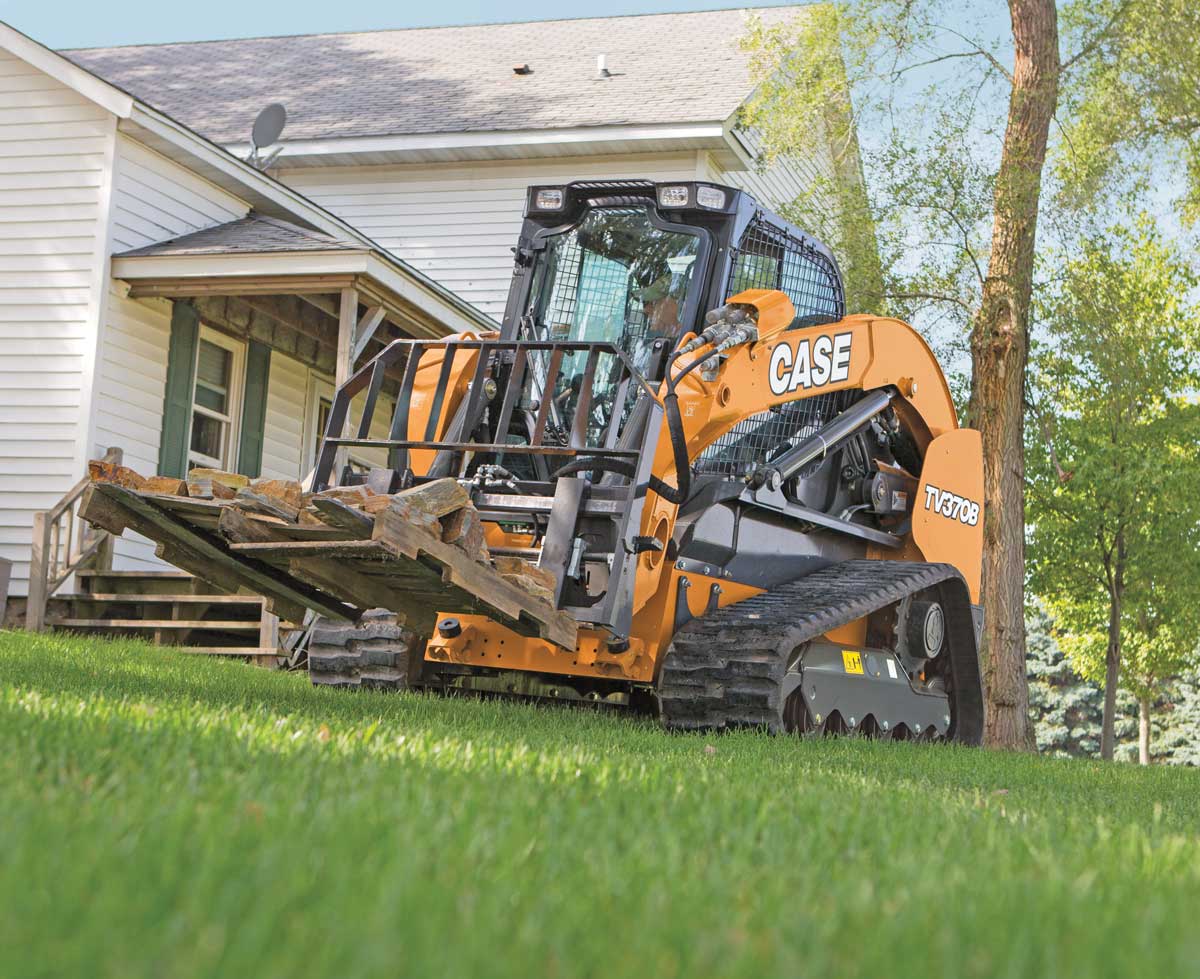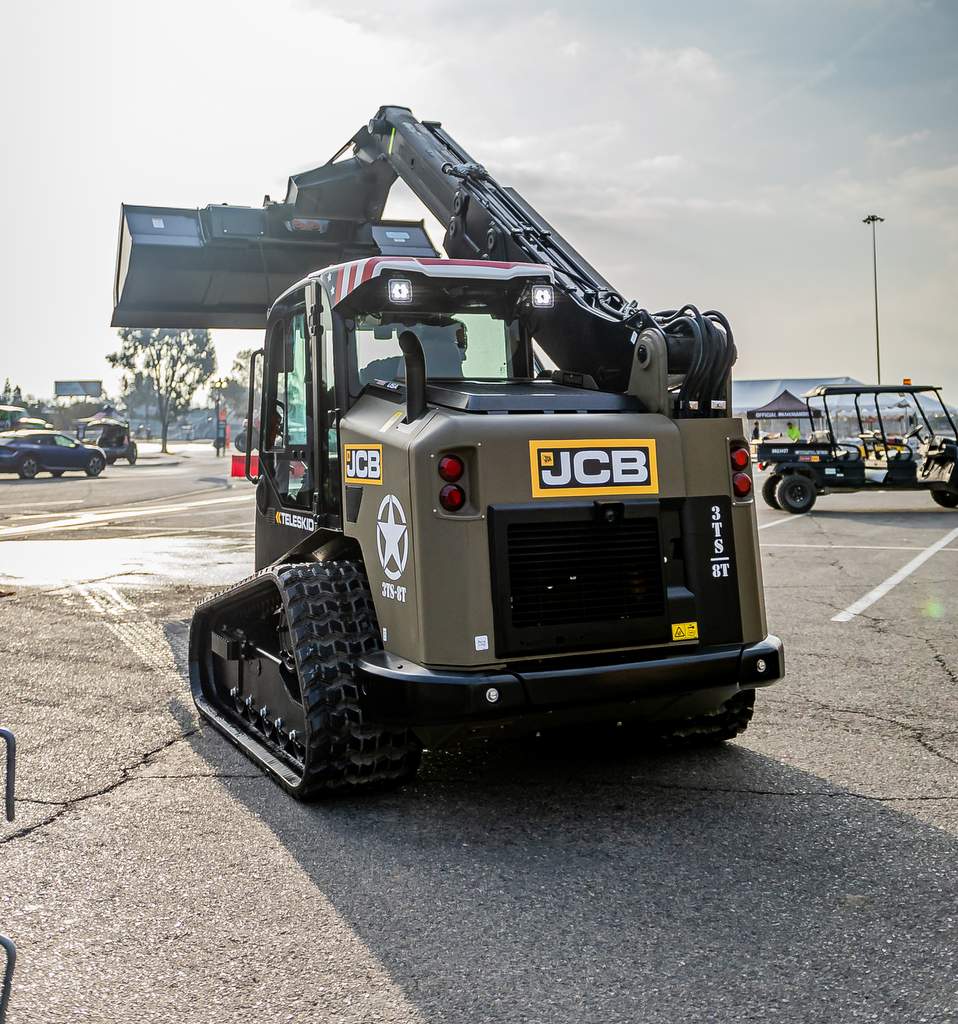Blade Runner
Bad weather looks worse through a window. Winter contractors understand how treacherous travel can appear to both pedestrians and pros when watching the snow fall behind the frosty glass of a medium-duty plow truck. Confidence is needed on highways, city streets, driveways and parking lots during the ice and snow of the coldest months, so traffic can flow in the worst winter storms, even behind barely-scrapped icy windshields.

Whether you’re a municipal crew or a small, entrepreneurial owner/operator, it’s a plow contractor’s job to give commuters a sense of certainty when navigating roadways in the winter. For plow professionals, that self-assurance comes from preparation — understanding local weather patterns, researching plow routes and parking lot plans and having the right equipment for the job — which means a properly outfitted plow truck. Now is the time to starting planning ahead.
“Purchase and prepare your equipment early. Many contracts require having equipment ready to roll by October 10,” says Mark Miller, marketing manager with Hiniker Co., a snowplow and spreader manufacturer from Mankato, Minn. “Buy locally. Parts and service availability are important if you have a problem at 4 a.m. Scout the area. Know where the pavement stops and the grass, shrubs and curbs begin before they are buried under 2 ft of snow. And don’t buy more than your truck can safely and effectively handle. Little trucks can’t take advantage of the capacity of great big plows, so buying the correct size and weight is essential.”
Winter warriors must be equipped with the right knowledge and weapons to battle a foe like ice and snow. For the snow removal pro, that means the ideal plow. Step onto the dealer lot of any of these snowplow manufacturers today (THE BOSS Snowplow, Hiniker, Machinability, Sno-Way, Meyer, SnowDogg and a zillion others) and you will discover two main configurations dominate the truck snowplow industry:
- Straight Blades — These blades clear snow quickly and easily in environments as narrow as a sidewalk or as expansive as a parking lot, using a heavy-duty blade that is straight. For increased maneuverability, a straight blade can be angled 30 to 45 degrees right or left for exact plowing. Price range is $3,000 to $4,000.
- V-Plows — These plows increase the plow pros ability to move snow more efficiently and carefully. The V-plow is a multi-position plow (V-position, scoop position, straight position and angle position) that gives your operations more versatility and accuracy. Price range is $4,000 to $6,000.
“Time is money for these guys, so the faster the surface is cleared, the more jobs that can be completed,” says Mark Klossner, marketing manager for BOSS, celebrating 25 years in the business in 2010. “The V-plow continues to grow in popularity because of its versatility. By changing the wing positions, the operator can literally add precision to snow placement and can tackle a variety of plowing conditions from fresh to ice-hardened snow.”
While V-plows are the most versatile blades, straight blades are still the most popular. V-plows are typically utilized by professionals and cities, while straight blade plows are used by both contractors and consumers. Smaller-size straight blades (popular with homeowners) usually size from 6 to 7 1/2 ft wide and are intended for non-commercial use with down-sized 4-by-4s, SUVs and light 1/2-ton pickups. Conventional straight blade plows are typically sold in 7 1/2-, 8-, 8 1/2- and 9-ft sizes, as well as some 10 ft ooters for medium-duty trucks.
“Straight blade plows are the most popular plows, primarily due to cost, ease-of-operation and vehicle applications,” explains Brian Smith, marketing manager with SnowDogg snowplows (a Buyers Co. brand for five years). “But V-plows allow operators to better control the direction of the push. The V-position cuts through heavier snow while the scoop position allows for better cleanup or maneuvering in tight spaces. Similarly, an expanding wing plow gives operators the flexibility to plow large areas with a 10-ft blade, then downsize on the fly to an 8-ft blade for tighter areas.”
V-plows are usually sold in 8 1/2- or 9 1/2-ft widths. Typically used in the forward facing position to capture and move snow when plowing parking lots, streets or other travel ways, the V-plow can also be operated in the V-position to break through deep unplowed snow or as a conventional windrowing plow. V-plows are significantly heavier and more expensive than a straight blade plow, but are more versatile.
There is a rigid V, which is a blade that does not change positions. Generally, this plow is used for big jobs clearing county roads and highways. Then there is a multi-position V-plow that can change from the scoop-position to the V-position to the straight or angle position or any position in between. This blade is usually used for parking lots, apartment building complexes and intersections.
Plows with Wings and Polymer
Over the last few years, snowplow professionals have been busy. Winter storms in the north have been especially prolific in places ranging from the Great Lakes Region to the Northern Plains. Good years have meant an increase in unique and powerful plow technology, specifically the plows that have extendable wings and blades that last longer.
The new popular plow on the block is the power wing plow. This is a snowplow with hydraulically powered wings, which can rotate 180 degrees allowing you to transform your plow from a straight pusher to a pusher box plow or even a back-drag plow with the push of a button. The hydraulic cylinders on the moldboard allow you to position the plow to windrow. You can even mount these plows onto smaller tractors or large wheel loaders. Some manufacturers have short 5-ft wings, which allow you to scoop under trailers and dock doors.
Another plow anomaly is called the extendable plow.
“It’s a rare, but extremely versatile plow that is capable of being configured to suit your needs on the fly,” explains Andrew Mason, engineer at Machinability Ltd., a plow manufacturer based in Oakville, Ontario, Canada. “A joystick handle allows you to control all eight hydraulic cylinders to extend, angle and even independently guillotine the side plates. The plow can be windrowing and still keep the wings pointing in the direction of travel. When you approach a laneway, guillotine the end plates closed to halt the flow of snow. Multiple sizes are available allowing you to alter the width of the plow from 8 to 14 ft or from 10 to 17 ft, which allows you to travel down narrower roadways and big open spaces.”
Some companies offer what’s called a C-plow or back-drag plow. This standout plow is great for loading docks, residential driveways and congested parking areas. The blade actually converts from a conventional plow into a back-drag plow (going face down into the snow) with the push of a button, letting you remove snow quickly and easily from garage aprons, curbs, loading docks and tight corners. Then touch a button again to flip the blade upright and push snow away again.
Besides style (straight, V, wings, extendable and back-drag), blade composite material is an important selection criteria for contractors. Steel plows have always been the traditional blade of choice for professionals (a most powerful and durable metal), but modern science has introduced polyethylene snow blades to the market as well (a durable polymerized ethylene resin).
“The advantages of polyethylene include low-friction, dent-resistance and improved appearance and life due to lack of corrosion,” explains Miller. “But steel plow skins are normally welded to the moldboard frame and become part of the moldboard structure. Polyethylene plow skins are bolted to the moldboard frame and do not add structural strength. That being said, in the case of a Hiniker plow, the moldboard frame for a poly plow is of a much stronger design, resulting in a stronger plow overall.”
Each manufacturer offers unique technologies, but typically poly plows are popular because of their slick, self-lubricating surface, which allows snow to slide off the blade quickly. Snow and ice tend to stick to the surface of steel plows. Another advantage of poly is that the blade material is saturated with color all the way through so nicks and scratches don’t show as much as on a steel plow that has seen years of fierce battle. The end result is that a poly blade tends to look new longer and it’s easier on your vehicle, but poly plows usually cost $200 to $300 more than steel plows.
Of course, steel blades have been around longer and they have many loyal users. Many of today’s grizzled plow masters grew up using steel moldboards and just aren’t comfortable changing to fancy alternative materials such as poly. Many still appreciate the plowing performance and durability of steel blades (they are usually stronger), including brands like Machinability’s Scoop Dogg and Buyers’ SnowDogg that only offer stainless steel today.
“Stainless steel plows are not only attractive, but they are also durable, relatively maintenance-free and resist sticking snow,” says Smith. “All SnowDogg snowplows feature heavy-duty stainless steel moldboards, and all SnowDogg plows are manufactured with the highest quality components in the USA to provide an outstanding product at an excellent value. We still think stainless steel plows offer the most value to our customers today.”
Installation and Maintenance
When purchased, most plows come with lights, hydraulics, blade, vehicle undercarriage and controls. Popular options can include snow deflectors (which attach to the main blade or plow wings to deflect snow away from the windshield) and plow wings (which attach to the sides of the plow and make it more of a scoop). Instructions for installation of a plow onto your truck typically look like this:
- Open all cartons and verify all parts are there
- Follow all instructions precisely
- Install the mount to the truck
- Assemble the frame to the mounting
- Assemble the frame to the moldboard
- Assemble accessories to the moldboard
- Install the wiring harness
- Install the plow lights
- Attach the plow to the truck mount
- Plow snow
While there are guidelines to follow to make sure you don’t pick a plow that will overload the capacities of your truck, there are a host of other features from which to choose. With every major manufacturer — BOSS, Hiniker, Sno-Way, Meyer and Fisher — comes a unique mounting system. For example, BOSS offers its SmartHitch 2 attachment system, while Hiniker has its Quick-Hitch mount and Meyer has the EZ-Mount Xpress. Although they each have fancy names, they essentially do a variation of the same thing. Like your favorite skid steer or compact track loader, these mounting systems offer a quick-attach that lets you attach or detach plows through the use of a hydraulic mounting system, instead of hopping out of the cab and trying to lift a heavy plow blade.
Selecting the right size plow is as important as installing it correctly. After assembling the blade and mounting it to the truck (per the instructions of your brand), you will need to set up your controls. The standard controls of today are installed directly into your truck’s cab and give the operator the ability to fully operate the snow blade from within the comfort of a cozy, heated enclosure.

“A handheld cab control is standard with all SnowDogg snowplows,” says Smith. “Large buttons for ease-of-use and an easy-grip handle are important. Integral diagnostics are built-in for easy field troubleshooting with smart output channels to prevent failure in case of overload or short circuit.”
Functionality and ergonomics set cab controls apart. Cab controls are typically part of the system’s main wiring harness and are usually plug and play (although today, some manufacturers even offer wireless controls). Most companies offer a standard cab control and then a second style or upgraded cab control. A good controller should be compact and easy to use. The controls should be raised so an intuitive plower can see and feel them, rather than lowering their eyes, distracting from the job at hand. The controller can often be Velcro-mounted to any surface in the cab for easy use.
“THE BOSS Snowplow offers several cab controls, including the SmartHitch 2, which offers a Snowplow Sight System allowing users to align their truck and plow from inside the cab for hookups on the first try,” says Klossner. “The SmartTouch 2 is a handheld control offering right- and left-hand compatibility and more mounting options than any other control. The SmartTouch 2 can be hand operated, attached to a pedestal mount, mounted on the dash or strapped to the leg.”
Along with mounting parts and cab controls, snowplows will have a variety of wear items that they will need to maintain, including cutting edges, plow shoes, hydraulic hoses and trip return springs. Cutting edges are the most expensive and can cost $150 to $300, depending on the size and model of snowplow. Plow shoes generally cost around $50 to replace. All of these items can be replaced in the field with basic tools.
Before you start the snow season, old and new plows will need to be checked thoroughly for such items. Check the plow’s hydraulic motor, change the hydraulic oil fluid, replace the filters, grease the electrical fittings and test the lights — both high and low beams. Take a good look at your plow — first investigating the welds on all the structural steel, including the moldboard, A-frame, sector/pivot bar and the mounting and lift frame. It is crucial that there are no cracks or excessive wear in the welds. Take a minute to eye the plow cutting edge too. Most cutting edges are about 6 in. and most operators who plow know that when it gets down to about 4 in., it’s time to replace the edge. It’s the same with the rubber shoes wearing too thin. If you’re plowing, you’ll eventually leave a groove if something is too worn.
V- and back-drag plows have extra hinge points that should be lubricated with a high-quality, general purpose grease. Also grease the king bolt, pivot pins/bolts and all hinge points, and take a look at the ground to check for any hydraulic leaks from the angling and lift cylinders. Double check the hydraulic hoses for cuts, abrasions and leaks. The best preventive maintenance for hydraulic systems is to change the fluid at the beginning of the season. If you don’t feel comfortable messing with the hydraulic system, it’s a good idea to take it to the dealer to have it done. Like most machinery, the local dealer is the best place to start and end when it comes to snowplow purchase and maintenance.
The key is to not wait until the snow has piled up before hooking the plow up to the truck. Start in September or October because when November rolls around and the snow is falling, you want your plow to work. By being prepared with the right truck and right plow, snow professionals can form the right plan, ensuring commuters and commerce can continue in neighborhoods with confidence this winter work season.
Keith Gribbins is managing editor for Compact Equipment, based in Peninsula, Ohio.
Blades of Safety
Ensure Your Plow and Crew Are Not Damaged During Jobsite Transportation
Snow contractors work long hours in inhospitable conditions, so safety is of the utmost importance. Crews should carry safety equipment for emergencies like a fire extinguisher, flashlight, flares, first aid kit, fuses for the vehicle, jumper cables, an ice scraper, lock deicer, extra washer fluid, a shovel and a bag of sand or salt. Also, make sure you have warm clothes that include insulated boots, insulated underwear, a warm jacket, hat, gloves and sunglasses. You also need to check that you are transporting your plow properly from job to job. Here a few pointers:
- When transporting a snowplow, angle the blade to the right (toward the curb). This will reduce the chance of catching a curb or a snow bank that could pull your vehicle into it.
- Never operate a plow while transporting it to and from a jobsite. It’s a good idea to keep the plow control turned off in order to prevent accidental operation.
- When transporting a plow, position the blade so as not to block the plow headlights or your vision.
- Do not exceed 40 mph when transporting a plow. Do not exceed 14 mph when plowing.
- When transporting a plow or while plowing, check the temperature gauge often. Overheating the engine can be costly. If the vehicle overheats, stop and correct the problem. If overheating occurs while transporting, stop and adjust blade position to allow more airflow to the radiator.
Information provided by Mark Klossner. He’s a marketing manager with THE BOSS Snowplow, based in Iron Mountain, Mich.





Comments are closed here.